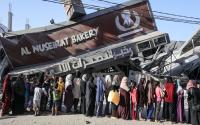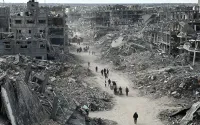IRAQ AND AL-QAEDA Part 1 - The usual suspects
Asia TimesBy Pepe Escobar
Nearly 100 Iraqis have been killed in less than 24 hours in two suicide bombings in Iskandariya and Baghdad. Most of them were poor and unemployed and were trying to find a job with the new, American-approved Iraqi police and army. They were Shi'ites in Iskandariya, and mostly Sunnis in Baghdad. But for the anti-occupation guerrilla forces, they were just one thing: collaborators. These two deadly attacks happened just as the Pentagon and the White house leaked information that allegedly proved the so far elusive link between al-Qaeda and terrorism in Iraq. According to the Bush administration, a "key al-Qaeda suspect" was arrested in Iraq carrying a 17-page memo on a computer disc, on his way to Afghanistan no less, where the disc was be handed over to Osama bin Laden, or his number two, Ayman al-Zawahiri. The author of the memo was purported to be Abu Musab al-Zarqawi, a Jordanian national on the loose and longtime number one suspect of being the missing link between al-Qaeda and Saddam Hussein's regime. In the memo, al-Zarqawi allegedly appeals to the al-Qaeda leadership to help detonate a civil war in Iraq between Sunnis and Shi'ites as the next definitive step to get rid of the Americans. For the Bush administration's spin machine, this is "the strongest evidence to date of contacts between extremists in Iraq and al-Qaeda". This latest US intelligence, though, makes little sense. For starters, al-Qaeda pigeons are highly unlikely to move around with computer discs in their briefcases: since early 2002 a disabled al-Qaeda has used women couriers to deliver strictly verbal messages. The memo says that the resistance against the occupation is "struggling to recruit Iraqis". This is not borne out by the situation on the ground - the resistance continues, even rising, despite the capture of Saddam. The purported memo also says that the "new anti-American campaign" must start before "zero hour", when power is scheduled to be transferred to an Iraqi administration in June. Again, this is not true. The resistance knows all too well that only the responsibility for security will be transferred in June, not power. The Americans will remain behind their heavily fortified military bases, but will remain as occupiers. Asia Times Online has been to Iskandariya. It's a dusty and very poor town roughly on the imaginary border between the Sunni triangle and the Shi'ite south. Sunnis and Shi'ites live close together with no major hassles. But Iskandariya is also fiercely anti-occupation. People there are proud of the local resistance attacks. This shows how the resistance is spreading, irrespective of sectarian, religious lines. The memo says that "if we succeed in dragging them [Shi'ites] into a sectarian war, this will awaken the sleepy Sunnis, who are fearful of destruction and death at their hands." The last thing the Shi'ites want is to be involved in a civil war: they are fighting for strong political representation in a new Iraqi government. Sunnis most of all want the end of the occupation - and the bulk of the Sunni resistance is a nationalist movement: they may welcome technical support from al-Qaeda, but not for a civil war. US Secretary of State Colin Powell was quick to defend the apprehended memo as giving "credence" to American claims, roughly one year ago, about an alleged connection between al-Qaeda and Saddam's regime. Powell even addressed the United Nations Security Council and made these charges. Saddam denied it; the radical group Ansar al-Islam, in the mountains of northeast Iraq, denied it; and no proof was ever found to substantiate the Americans' claims. Now the same scenario is resurrected to explain at least some of the dozens of attacks against American soldiers and the new Iraqi police and army. Conveniently, al-Zarqawi in his memo claims responsibility for "25 operations, some of them against the Shi'ites and their leaders, the Americans and their military and the police". The street version of one of the attacks differs from the official version - a suicide bombing via a pick-up truck loaded with explosives. Dozens of eyewitnesses said that they had heard a helicopter and the whoosh of a missile flying through the air just before the explosion. They later swore by Allah that the Americans brought a bulldozer to fill in the crater caused by the explosion. American commanders and Iraqi police chiefs continue to repeat the same mantra: the attacks show "al-Qaeda's fingerprints". Who profits from exploiting these "fingerprints"? The Bush administration, of course. With full exposure of the weapons of mass destruction sham, the official Washington excuse for the Iraq war has changed: now the spin is that Saddam was a bad guy, and terrorism in Iraq (which did not exist in the first place) must be fought. The ever-elusive bin Laden remains the main justification for the Bush administration. Yet what is qualified as "terrorism" in Iraq is being conducted by a cluster of the so-called "unaligned mujahideen", with only marginal input from al-Qaeda and other Islamist groups. The American non-governmental organization Iraq Body Count, in a still partial investigation that has not covered the whole country, has stated that there have been more than 10,000 civilian deaths in the Iraq war. As the number of seriously wounded in such wars is usually four times bigger than the number of fatal casualties, there may be 40,000 injured civilians. Russian observers estimate Iraqi military losses at 30,000 deaths and 120,000 seriously wounded. This means that many Iraqis now know that in the name of their "liberation", the Americans have killed or maimed 200,000 people. When something like this happens, you don't need any help from al-Qaeda to fuel your anger.






